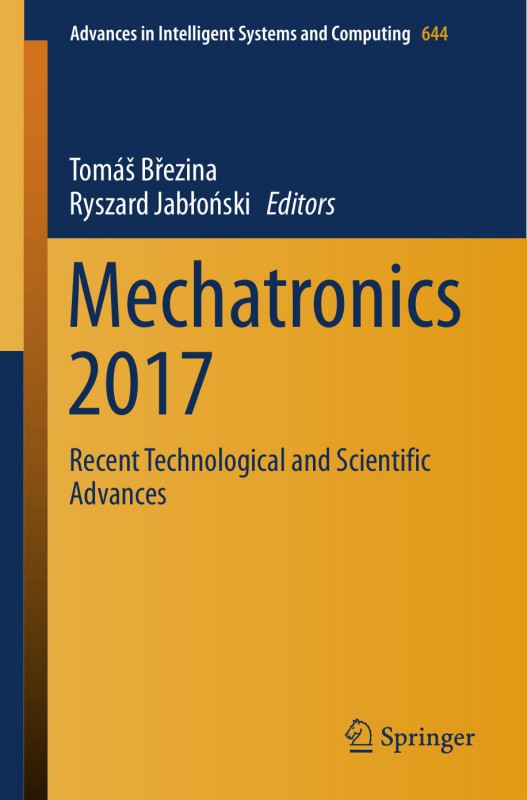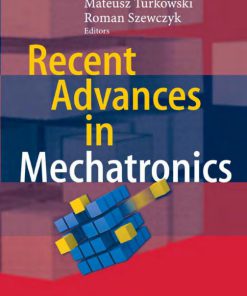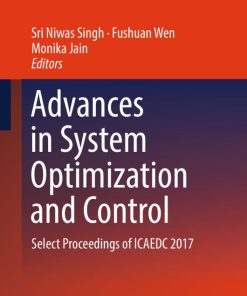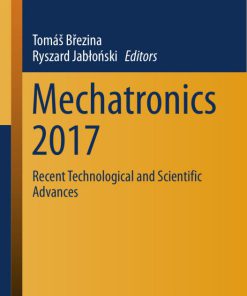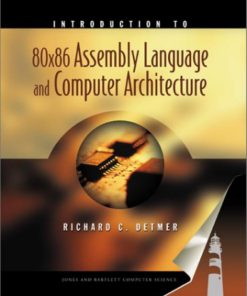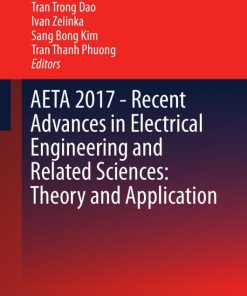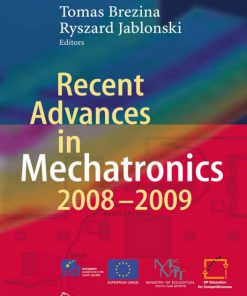(Ebook PDF) Mechatronics 2017 recent technological & scientific advances 1st edition by Tomáš Březina 331965960X 9783319659602 full chapters
$50.00 Original price was: $50.00.$25.00Current price is: $25.00.
Authors:Brezina, Tomas Jabłoński, Ryszard , Series:Mechatronics Engineering [142] , Author sort:Brezina, Tomas Jabłoński, Ryszard , Languages:Languages:eng , Published:Published:Mar 2021 , Publisher:Springer
Mechatronics 2017 recent technological & scientific advances 1st edition by Tomáš Březina – Ebook PDF Instant Download/DeliveryISBN: 331965960X, 9783319659602
Full download Mechatronics 2017 recent technological & scientific advances 1st edition after payment.
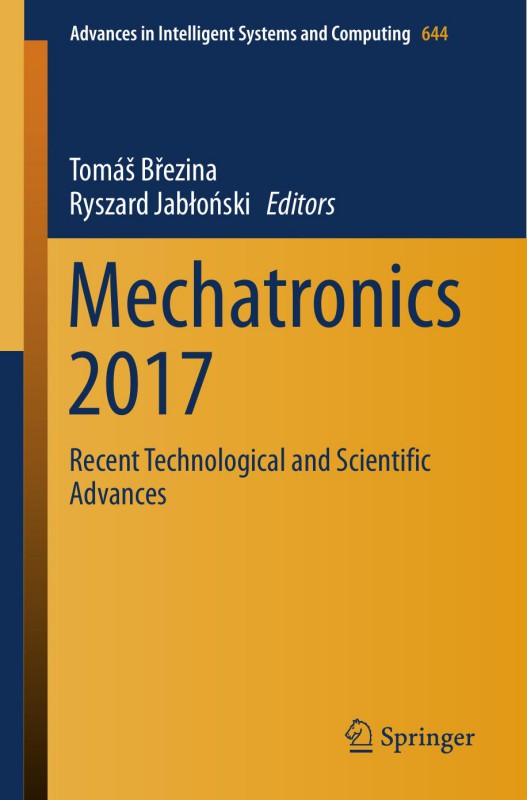
Product details:
ISBN-10 : 331965960X
ISBN-13 : 9783319659602
Author : Tomáš Březina
This book presents nearly 90 carefully selected contributions at the 12th International Conference Mechatronics, which took place in Brno, Czech Republic on 6–8 September 2017. Reflecting the most progressive and constantly changing areas of mechatronics, these proceedings includes papers concerning modeling and simulation, automatic control, robotics, sensors and actuators, electrical machines, and energy harvesting. It not only offers inspiration, but also deepens readers’ interdisciplinary and integrated understanding of modern engineering. The book is intended for experts in the integration of electronic, mechanical, control and computer sciences.
Mechatronics 2017 recent technological & scientific advances 1st Table of contents:
1 Introduction
2 Materials and Methods
2.1 Equations
2.2 Methods
2.3 Experimenal Setup
3 Results and Discussion
3.1 Covered and Uncovered Capillary Flow
3.2 Vertical Capillary Flow in Folded Filter Paper
3.3 Horizontal Capillary Flow
4 Conclusion
5 Future Work
Acknowledgement
References
Innovation of Pressing with TRIZ Methodology
Abstract
1 Introduction
2 Map of the Problem – RCA Diagram
3 Contradictions and Possible Solutions
3.1 Inventive Tasks as Technical and Physical Contradictions – TC1 and PC1
3.2 Inventive Tasks as Another Contradictions to Be Solved
4 Implementation of Found Inventions into Innovation
5 Conclusion
Acknowledgements
References
Evaluation of Postural Stability During Quiet Standing Using MatLab Software and Promising Parameter
Abstract
1 Introduction
2 Methods
2.1 Measurement Procedure and Measurement Equipment
2.2 Methods of Data Pre-processing and Processing
2.3 Time Domain Analysis Methods
2.4 Frequency Domain Analysis Methods
2.5 Analysis of Relationship Between Measured Variables
2.6 Nonlinear Methods
3 Application and Results
4 Discussion and Conclusion
Acknowledgements
References
Comparison of Deformation and Stress States of the Total Trapeziometacarpal Replacement
Abstract
1 Introduction
2 Computational Model
2.1 Model of Geometry
2.2 Model of Material
2.3 Boundary Conditions and Contacts
3 Results
4 Conclusion
References
Analysis of Single-Phase Voltage-Source Active Rectifier Under PWM
Abstract
1 Introduction
2 Single-Phase Voltage-Source Active Rectifier
2.1 Simulation Model
2.2 PWM Strategy
3 Simulation Results
4 Discussion
Acknowledgement
References
Minimization of Equivalent Series Resistance of Coupling Coils for Wireless Power Transfer Applicati
Abstract
1 Introduction
2 Equivalent Series Resistance Calculation
3 Optimal Cable Design
4 Conclusions
Acknowledgement
References
Optimal Efficiency and Power Control of High Efficient Wireless Power Transfer System
Abstract
1 Introduction
2 Basic Description of Regulation Technique Description
3 Regulation Principle
4 Simulation Model and Implementation Example
5 Measuring on Prototype
6 Conclusions
Acknowledgement
References
Design of Consecutive Compensator for Servo System with Signal Uncertainty
Abstract
1 Introduction
2 Formation of a Polynomial Dynamic Model of System Based on Besekersky Approach
3 Main Result. Algorithm of System Synthesis on the Basis of Besekersky Approach
4 Conclusion
Acknowledgements
References
Multi-criteria Decision-Making Problems in Cutting Tool Wear Evaluation
Abstract
1 Introduction
2 Selected Multi-criteria Decision Aid Methods
2.1 Multi-criteria Analysis
2.2 Selected Multi-criteria Decision Aid Methods
3 Selected Operating Problems
3.1 Shoulder Milling Cutter Wear Analysis
4 Tool Wear Estimation with AHP
5 Summary
References
The Novel Device for Irreversible Electroporation: Thermographic Comparison with Radiofrequency Abla
Abstract
1 Introduction
2 Electroporation
2.1 Plasma Membrane
2.2 Electrical Properties of Cells and Tissues
2.3 Reversible Electroporation
2.4 Irreversible Electroporation
3 Radiofrequency Ablation
4 Thermographic Comparison of IRE and RFA
5 Results and Discussion
6 Conclusion
Acknowledgements
References
High-Voltage Pulse Source for Cell Electroporation
Abstract
1 Introduction
2 Initial Analysis of Commercially Available Device
2.1 Analysis of Internal Structure of NanoKnife Device
2.2 Practical Verification of NanoKnife Output Parameters
3 Design of BUT Electroporating Generator
3.1 Definition of Required Output Parameters
3.2 Internal Structure of BUT Generator
3.3 Design of Pulse Transformer
3.4 Construction of Converter Power Stage
3.5 Operating Safety Issues
3.6 Operating Tests
4 Conclusion
Acknowledgement
References
Valve for Testing Rocket Engines
Abstract
1 Introduction
2 Structure of the Valve
3 Selection of the Drive
4 Simulation Study
5 Summary and Conclusions
References
System Approach to the Mass Production Improvement
Abstract
1 Introduction
2 Features of Mass Production and Ways to Increase Its Efficiency
2.1 Production Systems and the Theory of Constraints
2.2 Lean Manufacturing: Advantages and Problems
3 Results and Discussion: Simulation Models to Manage Mass Production and Human Resources
3.1 Optimization of Technological Processes on the Assembly Line
3.2 Ergonomics of the Workplace: The Impact on the Efficiency of Processes
4 Conclusions
References
An Automatic PCI Assignment Framework for Femtocells in LTE Networks
Abstract
1 Introduction
2 Related Works
3 Centralized PCI Assignment Mechanism
4 Conclusions
Acknowledgement
References
Classical Interpretation of Ultra-Low Intensity Optical Heterodyning as a Pragmatic Approach to Phot
Abstract
1 Introduction
2 Experiment
3 Interpretation of the Experimental Results
4 Conclusions
References
Numerical Integrator System for Drift Compensated Fluxmeter
Abstract
1 Introduction
2 General Idea and Project of Program
2.1 Input Signal Analysis
2.2 Output Signal Analysis
3 Software Implementation and Simulations
4 Hardware Implementation and Experiments
5 Conclusions
Acknowledgements
References
Investigation of Magnetic Properties of Amorphous Fe-Based Alloy Magnetized in Rayleigh Region
Abstract
1 Introduction
2 Object of Investigation
3 Measurement System
4 Experimental Results
5 Conclusions
Acknowledgements
References
Cutting Insert Wear Analysis Using Industry 4.0
Abstract
1 Introduction
2 Technology of Ball Screw Production
2.1 Virtual Reality
3 Experimental Setup
3.1 Machine and Tool for Manufacturing
3.2 Material of Ball Screw
4 Wear Analysis
5 Visualization of Wear in Virtual Reality
6 Conclusion and Discussion
Acknowledgment
References
Analysis of Machinability of Pure-Cobalt Disc for Magnetron Deposition Using WEDM
Abstract
1 Introduction
2 Experimental Setup and Material
3 Analysis of Machined Surface
3.1 Experimental Methods
3.2 Analysis of Morphology of Sample Surface
3.3 EDX Analysis of Chemical Composition
3.4 Topography of Machined Surface
4 Conclusion and Discussion
Acknowledgment
References
Using Industry 4.0 Technologies for Teaching and Learning in Education Process
Abstract
1 Introduction
2 Concept of Industry 4.0 and IoT
3 Modernization of the Asynchronous Motor Testbed
4 Conclusion
Acknowledgements
References
Mth Root Mth Power SNR MPSK Estimator
Abstract
1 Introduction
2 Signal Model
3 Mth Root Mth Power Algorithm
4 Hardware Implementation and Results
5 Performance Limitations
6 Conclusion
References
Electrical Machines
Increasing the Efficiency of Induction Generator in Small Hydro Power Plant for Varying River Flow R
Abstract
1 Introduction
2 Varying River Flow Rate
3 Efficiency of Induction Generator for Various Power
3.1 Power Losses in Induction Machine
3.2 Efficiency of Induction Generator for Changing Voltage and Power
3.3 Experimental Verification of Analytical Efficiency
4 Improvement of Efficiency by Voltage Change
4.1 Power Saving in One Year Period
5 Realization of Voltage Changing
6 Conclusion
Acknowledgement
References
Volume Minimization of Power Pulse Transformer for a Two-Switch Forward Converter
Abstract
1 Introduction
2 Goal of the Transformer Optimization, Definition of Conditions
3 Analytical Solution of the Optimization
4 Results for a Forward Converter with Output Parameters of 60 V/1 KW
5 Conclusions
Acknowledgement
References
Efficiency Mapping of a Small Permanent Magnet Synchronous Motor
Abstract
1 Introduction
2 Used Methods
2.1 Problem Formulation
2.2 Used Material
3 Theoretical Calculations
4 Results
4.1 Results Discussion
5 Conclusions
Acknowledgement
References
Dynamic Model of Wye Connected Induction Machine
1 Introduction
2 Dynamic Model of Induction Motor
2.1 Standard Dynamic Model
2.2 Dynamic Model with Line-to-Line Voltages
2.3 Space Vector Transformation and Dynamic Model
3 Conclusions
References
Induction Machine Models and Equivalent Circuits Based on Hybrid Parameters of Two-Port Network
Abstract
1 Introduction
2 Transformer Equivalent Circuit Based on Two-Port Network Parameters
3 IM Model Based on Two-Port Network Theory
4 Conclusion
Acknowledgements
References
Push–Pull Converter Transformer Maximum Efficiency Optimization
Abstract
1 Introduction
2 Definition of Parameters
2.1 Input Parameters
2.2 Output Parameters
3 Simplifications
4 Optimization Procedure
4.1 Winding Losses
4.2 Core Losses
4.3 Finding the Minimum Losses Point
5 Transformer Design Procedure
6 Design Example
7 Conclusion
Acknowledgement
References
Synchronous Machine Model Including Damper
Abstract
1 Introduction
2 The Types of Damper
3 Short Circuit Types
4 Mathematical Model
5 Examples of the Time Dependencies During the LN Type of Short-Circuit, Longitudinal Damper
6 Verification Measurement
7 Results Comparison for Various Damper Types
8 Conclusion
People also search for Mechatronics 2017 recent technological & scientific advances 1st:
2017 technological advancements
mechatronics review
mechatronics news
mechatronics engineering documentary
mechatronics zach star

